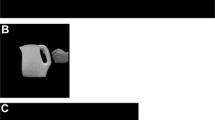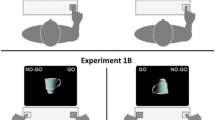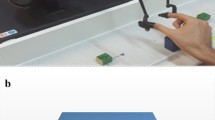Abstract
Recent evidence indicates that we experience manipulable objects as graspable, provided that they fall within our reaching space. Nevertheless, such evidence comes from studies using virtual objects that have poor ecological validity. Here, we used a spatial alignment effect paradigm and systematically examined this effect when a real handled object was presented at four different distances, namely near-reaching space, actual-reaching space, perceived-reaching space, and non-reaching space. Participants responded with either the right or the left hand as soon as the real object, a mug with the handle oriented toward the left or right, was presented. We found spatial compatibility effect only when the object was presented in the near-reaching and actual-reaching spaces. Results suggest that the activation of the potential actions to perform with objects is modulated by object accessibility. They also suggest that accessibility is exclusively linked to the actual rather than the estimated reaching ability of the perceiver. Results are discussed within the theoretical framework of embodied cognition.

Similar content being viewed by others
Notes
The only participant who did not overestimate his reaching range was excluded from this experimental session, because in that case it was not possible to differentiate between perceived- and actual-reaching space.
References
Ambrosini E, Scorolli C, Borghi AM, Costantini M (2012) Which body for embodied cognition? Affordance and language within actual and perceived reaching space. Conscious Cogn. (Epub ahead of print). doi: 10.1016/j.concog.2012.06.010
Bhalla M, Proffitt DR (1999) Visual motor recalibration in geographical slant perception. J Exp Psychol Hum Percept Perform 25:1076
Borghi AM, Riggio L (2009) Sentence comprehension and simulation of object temporary, canonical and stable affordances. Brain Res 1253:117–128
Bourgeois J, Coello Y (2012) Effect of visuomotor calibration and uncertainty on the perception of peripersonal space. Atten Percept Psychophys 74:1268–1283
Bub DN, Masson MEJ (2010) Grasping beer mugs: on the dynamics of alignment effects induced by handled objects. J Exp Psychol Hum Percept Perform 36:341
Cardellicchio P, Sinigaglia C, Costantini M (2011) The space of affordances: a TMS study. Neuropsychologia 49:1369
Carruthers G (2008) Types of body representation and the sense of embodiment. Conscious Cogn 17:1302
Chemero A (2001) What we perceive when we perceive affordances: commentary on Michaels “information, perception, and action”. Ecol Psychol 13:111–116
Chemero A (2003) An outline of a theory of affordances. Ecol Psychol 15:181–195
Chemero A (2009) Radical embodied cognitive science. MIT Press, Cambridge
Coello Y, Bartolo A, Amiri B, Devanne H, Houdayer E, Derambure P (2008) Perceiving what is reachable depends on motor representations: evidence from a transcranial magnetic stimulation study. PLoS One 3:e2862
Costantini M, Sinigaglia C (2011) Grasping affordance: a window onto social cognition. In joint attention: new developments. MIT press, Cambridge
Costantini M, Ambrosini E, Tieri G, Sinigaglia C, Committeri G (2010) Where does an object trigger an action? An investigation about affordances in space. Exp Brain Res 207:95
Costantini M, Ambrosini E, Scorolli C, Borghi A (2011a) When objects are close to me: affordances in the peripersonal space. Psychon Bull Rev 18:302–308
Costantini M, Ambrosini E, Sinigaglia C, Gallese V (2011b) Tool-use observation makes far objects ready-to-hand. Neuropsychologia 49:2658–2663. doi:10.1016/j.neuropsychologia.2011.05.013
Costantini M, Committeri G, Sinigaglia C (2011c) Ready both to your and to my hands: mapping the action space of others. PLoS One 6:e17923
Cutting JE, Vishton PM (1995) Perceiving layout and knowing distances: The integration, relative potency, and contextual use of different information about depth. Academic Press, San Diego
Delevoye-Turrell Y, Bartolo A, Coello Y (2010) Motor representations and the perception of space. Oxford University press, Oxford
Fischer MH (2000) Estimating reachability: whole body engagement or postural stability? Hum Mov Sci 19:297
Galati G, Committeri G, Spitoni G, Aprile T, Di Russo F, Pitzalis S, Pizzamiglio L (2008) A selective representation of the meaning of actions in the auditory mirror system. Neuroimage 40:1274–1286
Galati G, Committeri G, Pitzalis S, Pelle G, Patria F, Fattori P, Galletti C (2011) Intentional signals during saccadic and reaching delays in the human posterior parietal cortex. Eur J Neurosci 34:1871–1885. doi:10.1111/j.1460-9568.2011.07885.x
Gibson J (1979) The ecological approach to visual perception. Houghton-Mifflin, Boston
Glover S (2004) Separate visual representations in the planning and control of action. Behav Brain Sci 27:3–24 (discussion 24–78)
Griffiths D, Tipper SP (2012) When far becomes near: shared environments activate action simulation. Q J Exp Psychol (Hove) 65:1241–1249. doi:10.1080/17470218.2012.688978
Jeannerod M (1988) The neural and behavioural organization of goal-directed movements. Oxford University Press, Oxford
Jeannerod M (1995) Mental imagery in the motor context. Neuropsychologia 33:1419–1432
Loomis JM, Knapp JM (2003) Visual perception of egocentric distance in real and virtual environments. Erlbaum, Mahwah
Mark LS, Nemeth K, Gardner D, Dainoff MJ, Paasche J, Duffy M, Grandt K (1997) Postural dynamics and the preferred critical boundary for visually guided reaching. J Exp Psychol Hum Percept Perform 23:1365
Michaels CF, Zeinstra EB, Oudejans RRD (2001) Information and action in punching a falling ball. Q J Exp Psychol Sect A Hum Exp Psychol 54:69–93
Noë A (2004) Action in perception (representation and mind). MIT Press, Cambridge
Proffitt DR (2006) Embodied perception and the economy of action. Perspect Psychol Sci 1:110–122
Rizzolatti G, Sinigaglia C (2008) Mirrors in the brain. how our minds share actions and emotions. Oxford University Press, Oxford
Schnall S, Zadra JR, Proffitt DR (2010) Direct evidence for the economy of action: glucose and the perception of geographical slant. Perception 39:464–482
Shaw R, Turvey M, Mace W (1982) Ecological psychology: the consequence of a commitment to realism. Lawrence Erlbaum Associates, London
Thompson WB, Gooch AA, Willemsen P, Creem-Regehr SH, Loomis JM, Beall AC (2003) Compression of distance judgments when viewing virtual environments using a head mounted display. J Vision 3:18. doi:10.1167/3.9.18
Tsakiris M, Fotopoulou A (2008) Is my body the sum of online and offline body-representations? Conscious Cogn 17:1317
Tucker M, Ellis R (2001) The potentiation of grasp types during visual object categorization. Visual Cognit 8:769–800
Turvey M (1992) Affordances and prospective control: an outline of the ontology. Ecological Psychol 4:173–187
Turvey MT, Shaw RE, Reed ES, Mace WM (1981) Ecological laws of perceiving and acting: in reply to Fodor and Pylyshyn (1981). Cognition 9:237–304
Varela F, Thompson ET, Rosch E (1991) The embodied mind: cognitive science and human experience. MIT Press, Cambridge
Acknowledgments
MC was supported by a grant from the Volkswagen Foundation “European Platform for Life Sciences, Mind Sciences and the Humanities” (Ref: 85 639).
Author information
Authors and Affiliations
Corresponding author
Rights and permissions
About this article
Cite this article
Ambrosini, E., Costantini, M. Handles lost in non-reachable space. Exp Brain Res 229, 197–202 (2013). https://doi.org/10.1007/s00221-013-3607-0
Received:
Accepted:
Published:
Issue Date:
DOI: https://doi.org/10.1007/s00221-013-3607-0




